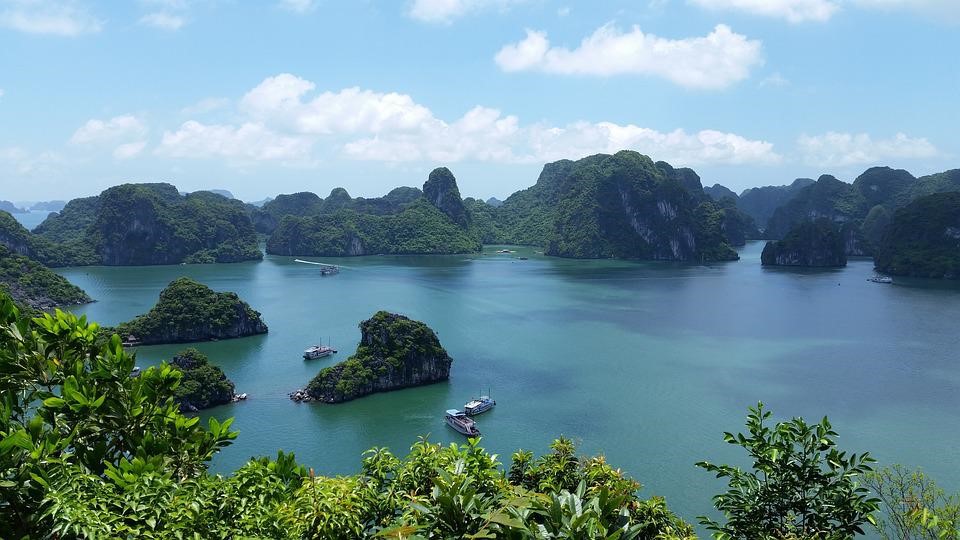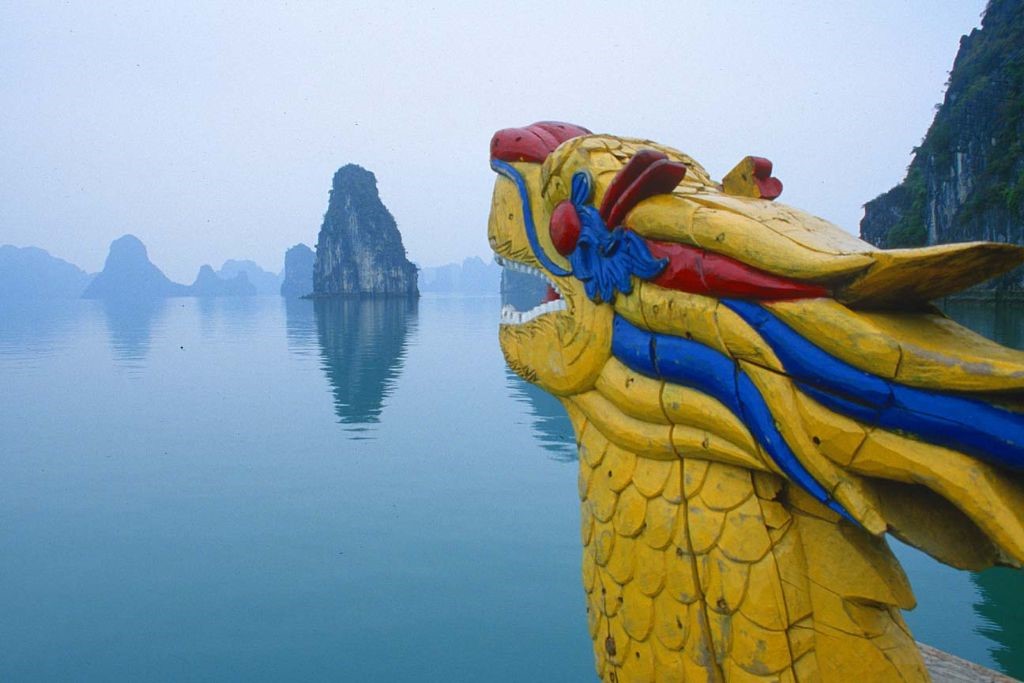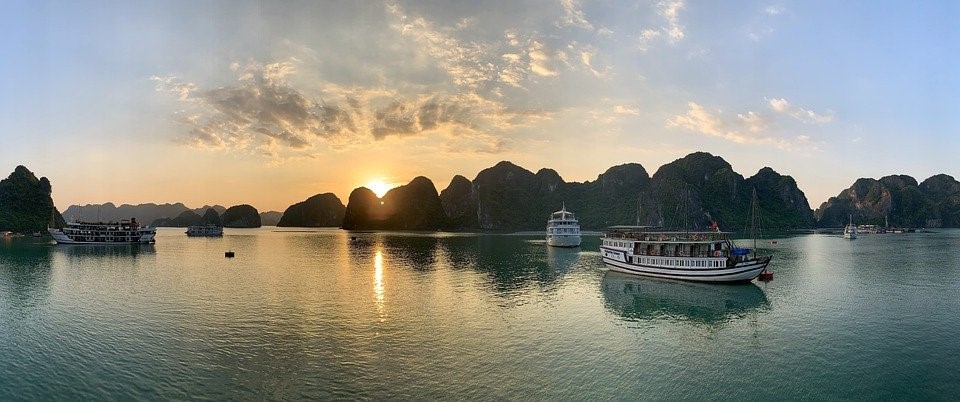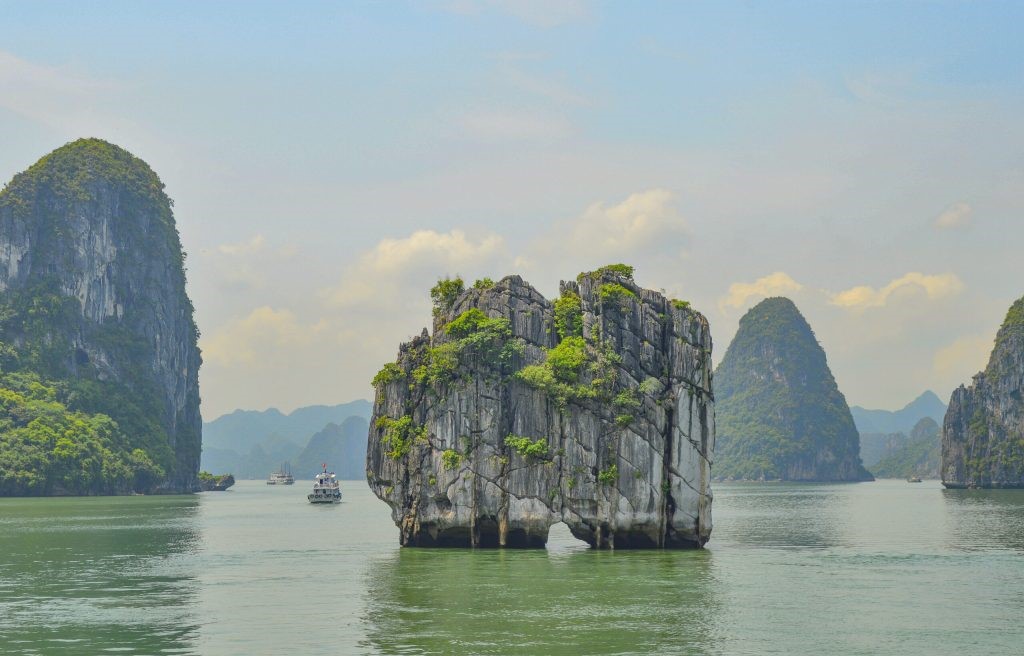
Find important information in the Halong Bay travel guide !
Legends are the foundation of Asia, weaving narratives that unite diverse peoples under shared celestial and terrestrial beings, often bearing the same name. The quintessential mythical creature in Asian lore is the dragon. But how does the dragon relate to the enchanting realm of the legendary Halong Bay in Vietnam? Let’s delve into this mystical region.
The Dragon’s Role in Halong Bay’s Creation:
Unveil the notion of Western dragon myths and envision a wingless dragon suspended in the skies, propelled by the evolving crest it garners. It resembles a lengthy serpent adorned with modest limbs. This dragon is attributed with an array of powers, including unintentional world-crafting abilities. Consider the authentic legend of Halong Bay’s genesis: As per the tale, the Jade Emperor, the celestial supreme ruler, dispatched a mother dragon and her offspring to safeguard the Vietnamese populace from the surrounding conflicts. Upon their descent, the dragon and its progeny scattered numerous jade gems and pearls across the land and sea. Yet, upon touching the water, these treasures metamorphosed into colossal stones that persist today, forming a formidable barrier against sea invaders.

Another narrative, perhaps more profound in authenticity, unveils a colossal dragon dwelling within Ha Long’s waters, an entity “as vast as the world and high as the sky.” Its sheer size supported the entire Annam land, spanning from Huê to the North and South deltas. One day, the water spirits, in alliance with humans, fish, and air spirits, conspired to vanquish the dragon. Suspicious, the dragon spewed forth a torrent of flames, turning all into enduring stone. Notably, this transformed the spirits of the waters, Tinh, the opposing current genius, and other beings into distinctive rock formations. Victorious, the dragon retreated to the North’s highest peak, diving into what is now the Gulf of Tonkin. Its undulating tail carved mountains, valleys, and crevices. As the waters surged, a few infertile rocky peaks and lands emerged, bearing witness to the dragon’s aquatic escapades.
Lastly, a harmonizing variant suggests an era when sea monsters menaced the land. The benevolent dragon, ancestor of the Vietnamese alongside the fairy Au Co, descended with its offspring to protect the nation. Spitting pearls that solidified into rocks, the dragon thwarted the invaders. Settling on earth, its movements sculpted Halong Bay, while a flick of its tail brought forth the islet of Bach Long Vi (Tail of the White Dragon). This dynamic dragon ballet engendered Bái Tu Long Bay (son of the prostrating dragon). Hence, Ha Long translates to “The Descent of the Dragon,” validating these legends.
Halong Bay, a natural shield against invaders
Irrespective of the legend, the dragon and its kin have undeniably played their part, albeit inadvertently challenging geological theories. The region’s historical significance is evident, with Halong Bay acting as a natural bastion against foreign incursions. This labyrinth of islands thwarted Chinese and Mongol invasions on three occasions. In more recent history, pirates used the bay’s intricate landscape to their advantage, navigating its waters in pursuit of river access. During the French colonial era, mapping and naming of islands occurred, revealing coal deposits exploited by the French Tonkin coal mining company, which, over time, contributed to environmental challenges in Halong Bay. Moreover, the bay’s karst formations served as a backdrop for significant events during the conflict with the United States.
Halong Bay, shrouded in legends and historical significance, holds a captivating allure that continues to intrigue and enchant visitors.

HALONG BAY TRAVEL GUIDE
When and How to enjoy Halong Bay
Halong Bay, often known as Miss UNESCO 1994, is a mesmerizing destination with its unique landscapes of around 2,000 limestone islands and islets. These incredible formations have made the bay a symbol of the country, located in both Deltas. The vast area of about 1500 km² that we commonly refer to as Halong Bay is actually composed of three distinct bays. Firstly, there’s the smaller Lan Ha Bay, situated to the south of Cat Ba Island. This bay is not accessible to cruise ships. Then comes Halong Bay itself, located north of Cat Ba Island. Lastly, there’s Bai Tu Long Bay, situated north of Halong Bay, which boasts larger islands, beautiful beaches, and fewer tourists.
Halong
Bay
In April, you can expect mostly sunny weather with no drizzles or fog, providing an ideal opportunity to appreciate the natural beauty of the bay. While temperatures might still be somewhat chilly early in the month, they start to rise towards the end of April. This period marks the beginning of the high tourist season, lasting from May until the end of September. Due to the popularity, it’s wise to book your accommodations well in advance.
From May to October, the weather is hot, making it the sunniest time to visit with clear skies. There might be occasional heavy showers during this time. However, be cautious of the risk of typhoons between the end of July and early October. During the winter months (late October to late January), visibility is generally good until Tet (around late January or early February). After Tet, there’s a higher chance of fog and persistent drizzle.

Exploring Halong Bay > Travel guide
Some fortunate individuals might opt for a seaplane ride over the bay, while the majority will enjoy a one or two-day cruise experience. Cruises can take place in Ha Long Bay, Lan Ha Bay, Bai Tu Long Bay, or even a combination of these bays. A one-day trip is also possible. Feel free to ask us for advice, as there are numerous possibilities to choose from. Alternatively, smaller and more intimate private junks are available, providing a truly authentic experience on the serene waters.
How to get to Halong Bay
Depending on the specific bay you plan to explore, you’ll either head to Tuan Chau port (for Halong and Bai Tu Long bays) or Hai Phong port (for Lan Ha Bay). If you’re visiting Lan Ha Bay, you’ll take a ferry from Hai Phong to Cat Ba Island, and then embark on your journey to Lan Ha. Convenient shuttle services are available from your hotel in the old quarter to the respective ports. To ensure a comfortable and enjoyable experience on the legendary waters of Halong Bay, it’s recommended to coordinate your excursion through a local travel agency.
Our recommended cruise to explore the legendary Halong Bay > https://puluongecogarden.com/halong-bay-tours-selection-by-eco-travel-go-green-vietnam/

Comments are closed.